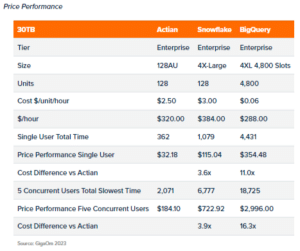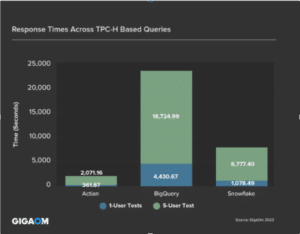2023 was another big year for the Actian Data Intelligence Platform. With more than 50 releases and updates to our platform, these past 12 months were filled with lots of new and improved ways to unlock the value of your enterprise data assets. Indeed, our teams consistently work on features that simplify and enhance the daily lives of your data and business teams.
In this article, we’re thrilled to share with you some of our favorite features from 2023 that enabled our customers to:
- Decrease data search and discovery time.
- Increase Data Steward productivity & efficiency.
- Deliver trusted, secure, and compliant information across the organization.
- Enable end-to-end connectivity with all their data sources.
Decrease Data Search and Discovery Time
One of the Actian Data Intelligence Platform’s core values is simplicity. We strongly believe that data discovery should be quick and easy to accelerate data-driven initiatives across the entire organization.
In fact, many data teams still struggle to find the information they need for a report or use case. Either because they couldn’t locate the data because it was scattered in various sources, files, or spreadsheets, or maybe they were confronted with an overwhelming amount of information, they didn’t even know how to begin their search.
In 2023, we designed our platform with simplicity. By providing easy and quick ways to explore data, the Actian Data Intelligence Platform enabled our customers to find, discover, and understand their assets in seconds.
A Fresh New Look for Actian Explorer
One of the first ways our teams wanted to enhance the discovery experience of our customers was by providing a more user-friendly design to our data exploration application, Actian Explorer. This redesign included:
New Homepage
Our homepage needed a brand-new look and feel for a smoother discovery experience. Indeed, for users who don’t know what they are looking for, we added brand-new exploration paths directly accessible via the Actian Explorer homepage.
- Browsing by Item Type: If the user is sure of the type of data asset they are looking for, such as a dataset, visualization, data process, or custom asset, they directly access the catalog with it pre-filtered with the needed type of asset.
- Browsing Through the Business Glossary: Users can quickly navigate through the enterprise’s business glossary by directly accessing the glossary assets that were defined or imported by stewards in Actian Studio.
- Browsing by Topic: The app enables users to browse through a list of items that represent a specific theme, use case, or anything else that is relevant to business (more information below).
New Item Detail Pages
To understand a catalog item at a glance, one of the first notable changes was the position of the item’s tabs. The tabs were originally positioned on the left-hand side of the page, which took up a lot of space. Now, the tabs are at the top of the page, more closely reflecting the layout of the Studio app. This new layout allows data consumers to find the most significant information about an item such as:
- The highlighted properties, defined by the Data Steward in the catalog design.
- Associated glossary terms, to understand the context of the item.
- Key people, to quickly reach the contacts that are linked to the item.
In addition, our new layout allows users to find all fields, metadata, and all other related items instantly. Divided into three separate tabs in the old version, data consumers now find the item’s description and all related items in a single “Details” tab. Indeed, depending on the item type you are browsing through, all fields, inputs & outputs, parent/children glossary items, implementations, and other metadata are in the same section, saving you precious data discovery time.
Lastly, the spaces for our graphical components were made larger – users now have more room to see their item’s lineage, data model, etc.
New Filtering System
Actian Explorer offers a smart filtering system to contextualize search results. Actian Data Intelligence Platforms preconfigured filters can be used such as by item type, connection, contact, or by the organization’s own custom filters. For even more efficient searches, we redesigned our search results page and filtering system:
- Available filters are always visible, making it easier to narrow down the search.
- By clicking on a search result, an overview panel with more information is always available without losing the context of the search.
- The filters most relevant to the search are placed at the top of the page, allowing to quickly get the results needed for specific use cases.
Easily Browsing the Catalog by Topic
One major 2023 release was our topics feature. Indeed, to enable business users to (even more) quickly find their data assets for their use cases, Data Stewards can easily define Topics in Actian Studio. To do so, they simply select the filters in the catalog that represent a specific theme, use case, or anything else that is relevant to business.
Data teams using Actian Explorer can therefore easily and quickly search through the catalog by topic to reduce their time searching for the information they need. Topics can be directly accessed via the Explorer homepage and the search bar when browsing the catalog.
Alternative Names for Glossary Items for Better Discovery
In order for users to easily find the data and business terms they need for their use cases, Data Stewards can add synonyms, acronyms, and abbreviations for glossary items.
Ex: Customer Relationship Management > CRM
Improved Search Performance
Throughout the year, we implemented a significant amount of improvements to enhance the efficiency of the search process. The addition of stop words, encompassing pronouns, articles, and prepositions, ensures a more refined and pertinent outcome for queries. Moreover, we added an “INFIELD:” operator, enabling users the capability to search for datasets that contain a specific field.
Microsoft Teams Integration
Actian Data Intelligence Platform also strengthened our communication and collaboration capacities. Specifically, when a contact is linked to a Microsoft email address, the platform now facilitates the initiation of direct conversations via Teams. This integration allows Teams users to promptly engage with relevant individuals for additional information on specific items. Other integrations with various tools are in the works.
Increase Data Steward Productivity & Efficiency
Our goal at the Actian Data Intelligence Platform is to simplify the lives of data producers so they can efficiently manage, maintain, and enrich the documentation of their enterprise data assets in just a few clicks. Here are some features and enhancements that help to stay organized, focused, and productive.
Automated Datasets Import
When importing new datasets in the catalog, administrators can turn on our automatic import feature which automatically imports new Items after each scheduled inventory. This time-saving enhancement increases operational efficiency, allowing Data Stewards to focus on more strategic tasks rather than the routine import process.
Orphan Fields Deletion
We’ve also added the to manage orphan fields more effectively. This includes the option to perform bulk deletions of orphan fields, accelerating the process of decluttering and organizing the catalog. Alternatively, Stewards can delete a single orphan field directly from its detailed page, providing a more granular and precise approach to catalog maintenance.
Building Reports Based on the Content of the Catalog
We added a new section in Actian Studio – The Analytics Dashboard – to easily create and build reports based on the content and usage of the organization’s catalog.
Directly on the Analytics Dashboard page, Stewards can view the completion level of their item types, including custom items. Each item type element is clickable to quickly view the catalog section filtered by the selected item type.
For more detailed information on the completion level of a particular item type, Stewards can create their own analyses. They select the item type and a property, and they’re able to consult, and for each value of this property, the completion level of all your item’s template, including its description, and linked glossary items.
New Look for the Steward Dashboard
Actian Explorer isn’t the only application that got a makeover. Indeed, to help Data Stewards stay organized, focused, and productive, we redesigned the dashboard layout to be more intuitive to get work done faster. This includes:
- New Perimeter Design: A brand new level of personalization when logging in to the dashboard. The perimeter now extends beyond dataset completion – it includes all the Items that one is a curator for, including fields, data processes, glossary items, and custom items.
- Watchlists Widget: Just as Data Stewards create topics for enhanced organization for Explorer users, they can now create watchlists to facilitate access to items requiring specific actions. By filtering the catalog with the criteria of their choice, Data Stewards save these preferences as new watchlists via the “Save filters as” button, and directly access them via the watchlist widget when logging on to their dashboard.
- The Latest Searches Widget: Caters specifically to the Data Steward, focusing on their recent searches to enable them to pick up where they left off.
The most popular items widget: The most consulted and widely used items within the Data Steward’s perimeter by other users. Each item is clickable, giving instant access to its contents.
Data Sampling on Datasets
For select connections, it is possible to get Data Sampling for datasets. Our Data Sampling capabilities allow users to obtain representative subsets of existing datasets, offering a more efficient approach to working with large volumes of data. With Data Sampling activated, administrators can configure fields to be obfuscated, mitigating the risk of displaying sensitive personal information.
This feature carries significant importance to our customers, as it enables users to save valuable time and resources by working with smaller, yet representative, portions of extensive datasets. This also allows early identification of data issues, thereby enhancing overall data quality and subsequent analyses. Most notably, the capacity to obfuscate fields addresses critical privacy and security concerns, allowing users to engage with anonymized or pseudonymized subsets of sensitive data, ensuring compliance with privacy regulations, and safeguarding against unauthorized access.
Powerful Lineage Capabilities
In 2022, we made a lot of improvements to our lineage graph. Not only did we simplify its design and layout, but we also made it possible for users to display only the first level of lineage, expand and close the lineage on demand, and get a highlighted view of the direct lineage of a selected item.
This year we made significant other UX changes, including the possibility to expand or reduce all lineage levels in one click, hide the data processes that don’t have at least one input and one output, and easily view the connections via a tooltip for connections that have long names.
However, the most notable release is the possibility to have field-level lineage. Indeed, it is now possible to retrieve the input and output fields of tables and reports, and for more context, add the operation’s description. Then, users can directly view their field level transformations over time in the data lineage graph in both Actian Explorer and Actian Studio.
Data Quality Information on Datasets
By leveraging GraphQL and knowledge graph technologies, the Data Intelligence Platform provides a flexible approach to integrating best-of-breed data quality solutions. It synchronizes datasets via simple query and mutation operations from third-party DQM tool via our catalog API capabilities. The DQM tool will deliver real-time data quality scan results to the corresponding dataset within the platform, enabling users the ability to conveniently review data quality insights directly within the catalog.
This new feature includes:
- A data quality tab in your dataset’s detail pages, where users can view its quality checks as well as the type, status, description, last execution date, etc.
- The possibility to view more information on the dataset’s quality directly in the DQM tool via the “Open dashboard in [Tool Name]” link.
- A data quality indicator of Datasets directly displayed in the search results and lineage.
Enable End-to-End Connectivity With all Their Data Sources
With the Actian Data Intelligence Platform, connect to all your data sources in seconds. Our platform’s built-in scanners and APIs enable organizations to automatically collect, consolidate, and link metadata from their data ecosystem. This year, we made significant enhancements to our connectivity to enable our customers to build a platform that truly represents their data ecosystem.
Catalog Management APIs
Recognizing the importance of API integration, the Actian Data Intelligence Platform has developed powerful API capabilities that enable organizations to seamlessly connect and leverage their data catalog within their existing ecosystem.
In 2023, the platform developed catalog APIs, which help Data Stewards with their documentation tasks. These catalog APIs include:
Query operations to retrieve specific catalog assets: Our API query operations include the retrieval of a specific asset, using its unique reference or by its name & type, or retrieving a list of assets via connection or a given Item type. Indeed, the platform’s catalog APIs enable flexibility when querying by being able to narrow results to not be overwhelmed with a plethora of information.
Mutation operations to create and update catalog assets: To save even more time when documenting and updating company data, the platform’s catalog APIs enable data producers to easily create, modify, and delete catalog assets. It enables the creation, update, and deletion of custom items and data processes as well as their associated metadata, and update datasets and data visualizations. This is also possible for contacts. This is particularly important when users leave the company or change roles – data producers can easily transfer the information that was linked to a particular person to another.
Property & Responsibility Codes Management
Another feature that was implemented was the ability to add code to properties & responsibilities to easily use them in API scripts for more reliable queries & retrievals.
For all properties and responsibilities that were built in the Actian Data Intelligence Platform (e.g.: Personally Identifiable Information) or harvested from connectors, it is possible to modify its name and description to better suit the organization’s context.
More Than a Dozen More Connectors to the List
Actian Data Intelligence Platform has advanced connectors to automatically synchronize metadata between our data discovery platform and all your sources. This native connectivity saves you the tedious and challenging task of manually finding the data you need for a specific business use case that often requires access to scarce technical resources.
In 2023 alone, we developed over a dozen new connectors. This achievement underscores our agility and proficiency in swiftly integrating with diverse data sources utilized by our customers. By expanding our connectivity options, we aim to empower our customers with greater flexibility and accessibility.
About Actian Corporation
Actian empowers enterprises to confidently manage and govern data at scale. Actian data intelligence solutions help streamline complex data environments and accelerate the delivery of AI-ready data. Designed to be flexible, Actian solutions integrate seamlessly and perform reliably across on-premises, cloud, and hybrid environments. Learn more about Actian, the data division of HCLSoftware, at actian.com.




















